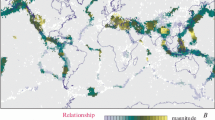Abstract
Stochastic models of self-organized criticality and intermittent criticality are used to describe the structure of seismic catalogs. The intermittent models introduce three phases of the seismic cycle: increase in seismic energy, seismic relaxation, and seismic quiescence after the final relaxation. In this paper, seismic mining catalogs from a deep copper mine are searched to find these three phases of the seismic cycle. In spite of the differences between the seismic records from earthquakes and the building of stresses in the mine, the cycles can be estimated in mining seismicity.
















Similar content being viewed by others
References
Bak P, Tang C (1989) Earthquakes as self organized critical phenomenon. J Geophys Res 94:15635–15689
Gibowicz SJ, Kijko A (1994) An introduction to mining seismology. Academic, San Diego
Lasocki S (2008) Some unique statistical properties of the seismic process in mines. In: Potvin Y (ed) Proceedings of the 1st Southern Hemisphere International Rock Mechanics Symposium, Vol. 1: Mining and Civil. Australian Centre for Geomechanics, Perth, pp 667–678
Main IG, Al-Kindy H (2002) Entropy, energy, and proximity to global earthquake populations. Geophys Res Lett 29(7):25-1–25-4
Main IG, Burton PW (1984) Information theory and the earthquake frequency magnitude distribution. Bull Seismol Soc Am 74:1409–1426
Main IG, Naylor M (2010) Entropy production and self-organized (sub)criticality in earthquake dynamics. Phyl Trans R Soc 368:131–144
Marcak H (2002) The influence of strata and tectonics on the rockburst risk in Polish mines. In: Ogasawara H, Yanagidani T, Ando M (eds) Seismogenic process monitoring. Balkema, Rotterdam, pp 51–63
Marcak H (2012) The seismic activity due to the bending of exploited seam roof. Archives of Mining Sciences 56/1:229–250
Olami Z, Feder H, Christensen K (1992) Self organized criticality in a continues nonconservative cellular automation modeling earthquake. Phys Rev Letter 68:1244–1247
Rundle JB (1993) Magnitude–frequency relation for earthquake using a statistical mechanical approach. J Geophys Res 98(21):943–949
Sammis CG, Smith SW (1999) Seismic cycles and the evolution of stress correlation in cellular automation model of finite fault networks. Pur Appl Geophys 155:307–324
Turcote DL (1999) Seismicity and self organized criticality. Phys Earth planet Int 111:275–293
Węglarczyk S, Lasocki S (2009) Studies of short and long memory in mining-induced seismic processes. Acta Geophysica Special Section: Triggered and Induced Seismicity 57(3):696–715
Acknowledgments
This work was supported by the Polish Ministry of Science under research project no. N52393539.
Author information
Authors and Affiliations
Corresponding author
Rights and permissions
About this article
Cite this article
Marcak, H. Cycles in mining seismicity. J Seismol 17, 961–974 (2013). https://doi.org/10.1007/s10950-013-9365-4
Received:
Accepted:
Published:
Issue Date:
DOI: https://doi.org/10.1007/s10950-013-9365-4




